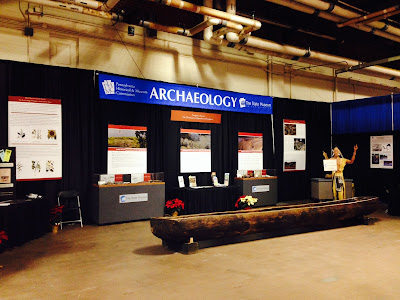This year is the 102nd
anniversary of the Pennsylvania State Farm Show. According to the Farm Show web
site it is the “largest indoor agricultural exposition in the nation, with
nearly 6,000 animals, 10,000 competitive exhibits and 300 commercial exhibits.”
The Section of Archaeology at The
State Museum of Pennsylvania will again host an exhibit, complete with an
authentic replica of a 20-foot long dugout canoe. Our exhibit is entitled Foragers to Farmers, the Development
of Agriculture in Pennsylvania. As you read in our last blog, Native
Americans and then early settlers had a close connection to the land, which
served to provide them with food and medicine. This exhibit explores some of
those plants and how they were utilized by our ancestors and showcases some of
the artifacts from Pennsylvania.
View
of the State Museum of Pennsylvania’s Booth at the Farm Show
Farming is more labor
intensive than hunting and gathering and there is a debate in archaeology as to
why early Indian populations in Pennsylvania gradually began focusing on seed
plants such as goosefoot, lambs quarter, and maygrass for food; eventually
growing these plants in gardens and finally adding maize to their diet. The
dependence on maize in the diet begans about A.D. 1000 eventually leading to
the development of large villages and
significant changes in social organization. During the 1700s, European farms
began to dominate the region and farming changed to include livestock and
grains. By the late 19th and early 20th century, farming
became more mechanized and fed huge numbers of people. The artifacts on display
document this change over the past 5,000 years.
A corn grinding station
utilizing stone tools allows visitors to experience the process used by native
peoples. Corn quickly became a food
staple after A.D. 1200, spurring dramatic social changes. Small egalitarian groups of people grew into tribal
societies. Another station will share information on types of native foods
still utilized today and some recipes that you can try at home.
Artifact
Case at the State Museum Booth
This event is always an
excellent opportunity for the State Museum staff to connect with the
community. We talk to an average of
40-50,000 visitors each year at the Farm Show and share our knowledge with
interested citizens of the Commonwealth.
One of our goals in reaching out to the community is to share the
significance of archaeology and to stress the importance of recording
archaeological sites. The Pennsylvania
Historical and Museum Commission is the state agency for preserving our
historical and archaeological heritage.
The State Historic Preservation Office (SHPO) records and maintains the
files for all known sites across the Commonwealth. This database of information enables state
agencies such as PENNDOT to plan for highway projects that will have the least
amount of impact on archaeological resources.
Archaeology is a labor intensive and an expensive undertaking. Avoiding sites reduces the expense of building
roads or bridges.
The Society for Pennsylvania
Archaeology (SPA) is also participating in our exhibit as they have in past
years. Representatives are on hand to
answer questions about the Society and membership which includes the biannual
journal, Pennsylvania Archaeologist,
newsletters and meeting announcements.
As an additional benefit of joining at the Farm Show you will receive
three past issues of the SPA journal.
Society
for Pennsylvania Archaeology Table at the State Museum Booth
Our booth will be located
opposite the carousel in the Main Exhibition Hall of the Farm Show
Complex. The Farm Show runs from
Saturday, January 6 through Saturday, January 13, and is open from 8:00 am to
9:00 pm each day except the 13th when it closes at 5:00 pm. Mark
your calendar and plan your visit to the 102nd Pennsylvania Farm
Show (http://www.farmshow.pa.gov/Pages/default.aspx). Be
sure to join us at the State Museum’s booth and take a ride in the dugout
canoe.
For more information, visit PAarchaeology.state.pa.us or the Hall of Anthropology and Archaeology at The State Museum of Pennsylvania .





No comments:
Post a Comment